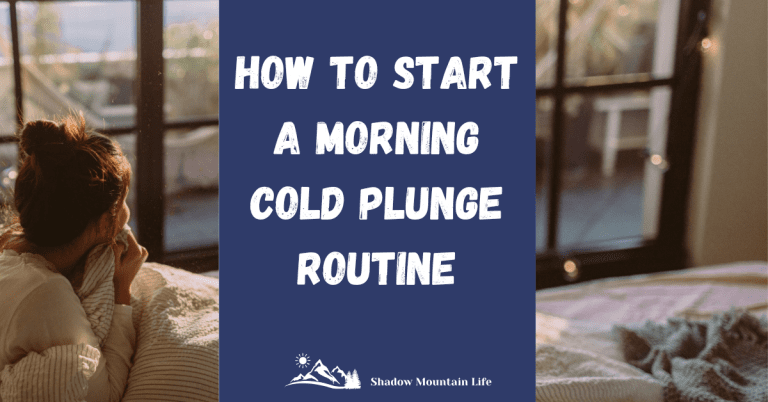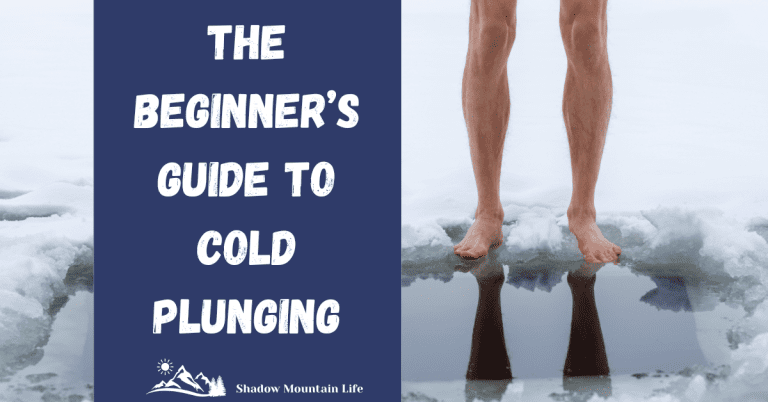How to Safely Start Cold Plunging: A Beginner’s Guide
Medical Disclaimer: We are not doctors. The health information in the article is for informational and educational purposes only. Please consult your doctor or other healthcare professional when making medical decisions.
Affiliate Disclaimer: We may make a commission if you purchase something through our links. Thank you!
How to Safely Start Cold Plunging
Are you interested in how to safely start cold plunging and make it a regular part of your wellness routine? Are you also curious as to why someone would willingly put themselves in an ice bath or run into a cold lake?
Cold plunging has numerous physical and mental health benefits and has experienced a strong following in the past few years as it has been discovered by more and more people. From 30 day lake challenges to people filling tubs with ice in their backyards, cold plunging can be seen everywhere on the internet.
However, it’s important to practice cold plunging safely and slowly. Jumping into cold water without proper preparation can be a jarring and even dangerous experience.
This beginner’s guide to cold plunging will provide you with a roadmap to start safely and effectively. Whether you’re looking to enhance your physical health, boost your mental resilience, or simply explore a new wellness practice, following these guidelines will help ensure a positive plunging experience.

Understanding Cold Plunging and My Experience
Cold plunging involves immersing the body in cold water, typically at temperatures below 59°F (15°C), for a short time period. This method has been used for centuries in various cultures, from the ancient Greeks and Romans, who believed in the health-boosting powers of cold baths, to the Scandinavian traditions of alternating between hot saunas and icy lakes.
Cold plunge therapy devotees claim improved circulation, enhanced muscle recovery, increased alertness, and a sense of mental clarity. The cold shock triggers the release of endorphins and norepinephrine, chemicals that elevate mood and reduce inflammation and swelling. As the body warms up afterward, the increasing blood flow promotes muscle recovery and circulation.
I was hesitant to try the cold plunge at first. I mean, who actually chooses deliberate cold exposure? However, my husband had recently put a DIY tub in our backyard for cold plunges at home, and was expounding on its benefits and how good he felt after using it. So, after a hot sauna session one night, I tried taking a cold shower. It took my breath away but felt refreshing at the same time. However, I still wasn’t sold on full on cold water immersion just yet.
After doing this for a few weeks, I finally decided to try the actual cold plunge. Stepping into the cold water was both exhilarating and slightly frightening. My breathing sped up and it became a game of mind over matter. After the initial shock, I found it actually felt really good and I enjoyed sitting in the tub under the stars in our backyard. From then on, I’ve looked forward to incorporating cold water therapy with my sauna sessions.
Preparing for Your First Cold Plunge
Preparing for your first cold plunge involves several key steps to ensure a safe and enjoyable experience. Be sure to check in with a healthcare professional, especially if you have pre-existing conditions such as a previous heart attack or unstable angina.
Decide if you will use a tub or a natural body of water such as a lake or river. Make sure the location is somewhere easily accessible as this will ensure that you will be able to make it a regular practice.
Use a thermometer to check the water temperature and grab some appropriate swimwear, and a towel. If you are going to a river or lake, you may want some sandals.

Step-by-Step Guide: Try a Cold Plunge in the Shower First
For most people, cold water immersion can be intimidating, but there are ways to ease your body into it. Starting with a cold shower is a great way to test your body and see how you acclimate to cold water and showers are easily accessible at home or at the gym. Begin by lowering the temperature at the end of your regular shower for 30 seconds and progressively increase this duration as your tolerance builds.
Cold showers help your body adapt to the initial shock and teach you controlled breathing, which is important for cold plunging. And, you will start gaining health benefits even without full body immersion.
If you are ready to try full-body cold immersion, lakes and rivers can provide a great experience, but make sure they are safe and free from strong currents and steep drop-offs. It’s also wise to take a friend along, especially when trying out a new location.
You can also use a cold plunge pool or tub, where you can control the temperature. Cold plunge tubs can be as simple as a DIY stock tank from Home Depot all the way up to a designer model tub with a built-in chiller.
During the Cold Plunge
During the cold plunge ease your body slowly into the water, rather than jumping in as this allows your body to acclimate gradually. Once in the water, focus on maintaining a steady, controlled breathing pattern to manage the body’s natural stress response.
I found that bringing my arms over my chest with my hands near my face and focusing on a hill in the distance helped me to stay focused and steady my breathing as I submerged.
Start with shorter immersion times working up to 2-3 minutes as you become more comfortable. But don’t torture yourself! The goal is to quickly benefit from the cold, not to stay in for an extreme length of time.
Post-Plunge Care
After exiting the cold water, dry off immediately and dress in warm, dry clothing to retain body heat and warm up your body temperature. If you are at a lake or river, bringing a thermos of tea or hot chocolate can help warm you quickly on the car ride or walk home.
Building a Cold Plunging Routine
Build your routine by going two to three times per week for about 1-2 minutes per time. You may want to do it at the end of a gym session with a cold shower or you may find the peaceful calmness of an early morning outdoor plunge suits you better.
My favorite time to cold plunge is while taking a break from the sauna. During most months of the year, I try and do this 2-3 times per week. If you have access to a sauna, combining the hot and cold therapy is the way to go. The health benefits of the sauna combined with the health benefits of cold therapy can’t be beat!
Check out the many benefits of a sauna after a workout here.
Safety Tips and Common Mistakes to Avoid With Cold Exposure
There are some risks and safety tips to be aware of when starting. It’s a good idea to avoid plunging alone, in a fast current, or extreme weather conditions.
Watch out for the signs of hypothermia which involve uncontrollable shivering, slurred speech, drowsiness, or confusion, and get out immediately if this happens.
Make sure to have a place easily accessible to warm up quickly afterward.
Remember to enjoy the adventure and start slowly. You don’t need to be a superhero on your first time out. Test your body with cold showers first, managing your body’s response in a safe, controlled environment. Then enjoy cold plunging outside as you feel more confident.
Some communities have groups of people who meet up to plunge together. This not only helps with being consistent as a beginner but will give you a community that is looking to improve their health as well.

Additional Resources
If you are looking for some science-backed articles related to the benefits of cold plunging, I’ve listed a few below:
1. Hjorth P, Sikjær MG, Løkke A, Jørgensen AM, Jørgensen N, Kaasgaard DM, Rasmussen MRV. Cold water swimming as an add-on treatment for depression: a feasibility study. Nord J Psychiatry. 2023 Oct;77(7):706-711. doi: 10.1080/08039488.2023.2228290. Epub 2023 Jun 28. PMID: 37381680.
2.Huttunen, P., Kokko, L., & Ylijukuri, V. (2004). Winter swimming improves general well-being. International Journal of Circumpolar Health, 63(2), 140–144. https://doi.org/10.3402/ijch.v63i2.17700
3. Reed EL, Chapman CL, Whittman EK, Park TE, Larson EA, Kaiser BW, Comrada LN, Wiedenfeld Needham K, Halliwill JR, Minson CT. Cardiovascular and mood responses to an acute bout of cold water immersion. J Therm Biol. 2023 Dec;118:103727. doi: 10.1016/j.jtherbio.2023.103727. Epub 2023 Oct 14. PMID: 37866096; PMCID: PMC10842018.
Looking to buy your own cold plunge? Check out some great options at Redwood Outdoors and Plunge.










